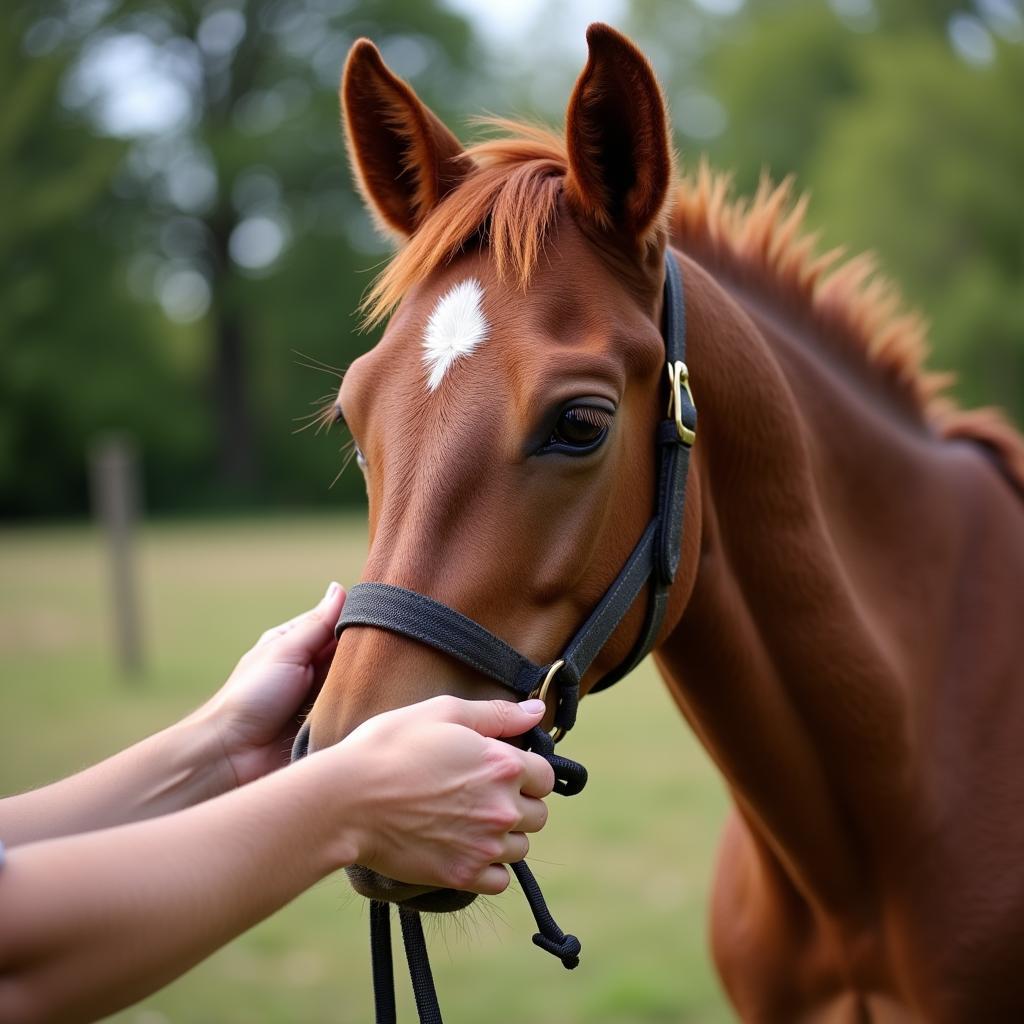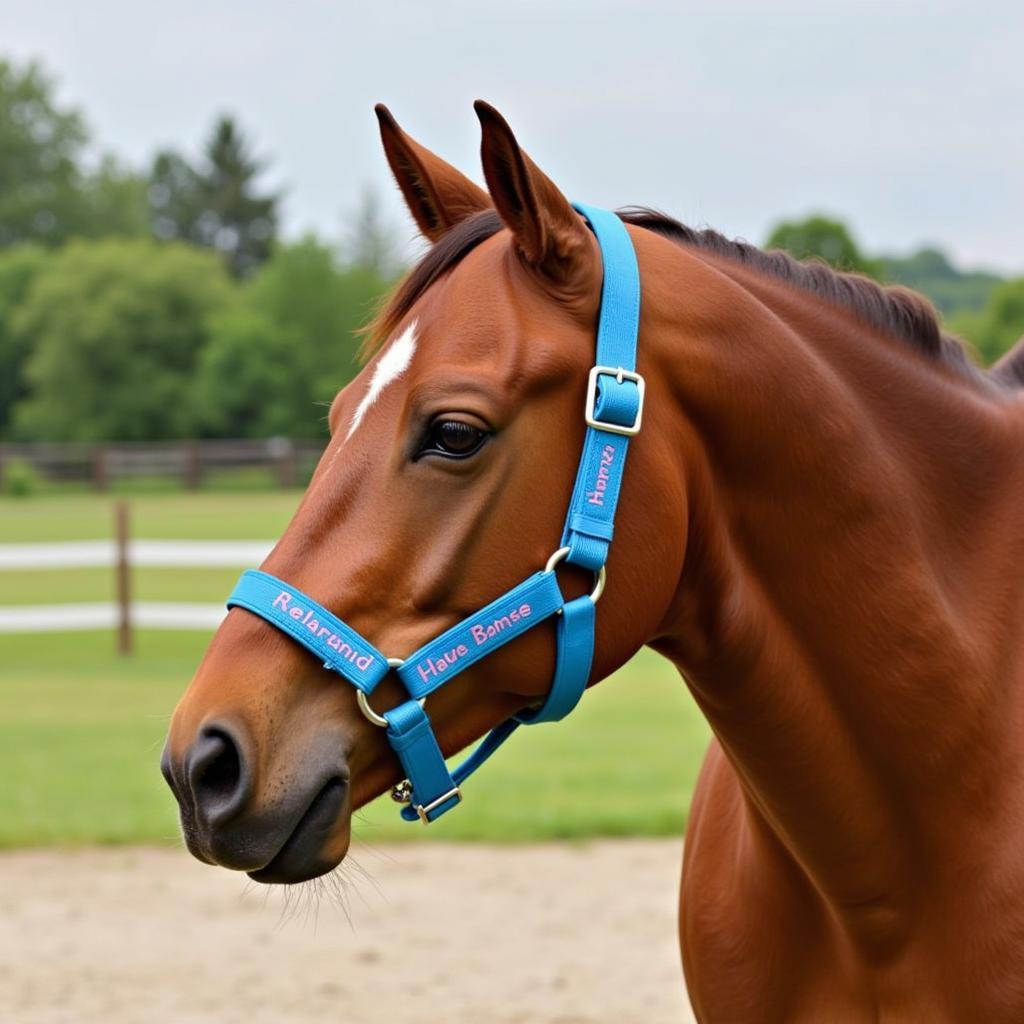A halter on a horse is more than just a piece of equipment; it’s a fundamental tool for communication, control, and safety. Understanding how to properly fit and use a halter is crucial for any horse owner. This guide will provide you with everything you need to know about halters, from selecting the right one to mastering the art of haltering your horse.
Choosing the Right Halter for Your Horse
Selecting the appropriate halter is the first step towards a positive experience for both you and your horse. Consider the material, size, and style to ensure a comfortable and secure fit. Leather halters offer classic durability and a refined look, while nylon halters are known for their affordability and easy maintenance. For training or showing, a rope halter can provide more precise communication. Sizing is crucial for safety and comfort, ensuring the halter doesn’t restrict breathing or chafe the horse’s skin. Check out our range of leather halter horse options for a premium choice.
Choosing the right size is crucial. A halter that’s too tight can restrict breathing and cause discomfort, while a halter that’s too loose can easily slip off, posing a safety hazard. Measure your horse’s head carefully and refer to sizing charts to ensure the perfect fit. For young horses, adjustable halters allow for growth and ensure a snug fit as they mature.
 Putting a Halter on a Young Horse
Putting a Halter on a Young Horse
The Art of Haltering: A Step-by-Step Guide
Approaching your horse calmly and confidently is key to a successful haltering experience. Speak to them softly and let them know you’re there. Once they acknowledge your presence, stand slightly to the side of their head, facing the same direction. Hold the halter in your left hand, with the crown piece draped over your right forearm. Gently place the noseband over the horse’s nose and lift the crown piece over their ears, securing the buckle.
Ensure the halter fits snugly but not too tightly. You should be able to fit two fingers comfortably between the halter and the horse’s cheek. For more detailed instructions on training a young horse to accept a halter, check out our guide on halter breaking horses.
Common Halter Problems and Solutions
Sometimes, you might encounter challenges when haltering your horse. They might be hesitant, pull away, or even try to rub the halter off. Patience and understanding are crucial in these situations. If your horse is resistant, try using a treat or positive reinforcement to encourage them to accept the halter. If they continue to struggle, consult a professional horse trainer for guidance. Looking for something a little different? We have a great selection of cute horse halters. A blue horse halter might just be the perfect pop of color.
A common issue is a horse rubbing its halter against fences or other objects. This can lead to damage to both the halter and the horse. Ensure the halter fits properly and consider using a breakaway halter for added safety in turnout situations. For a more personalized touch, consider a personalised horse halter.
 Horse Wearing a Personalized Halter
Horse Wearing a Personalized Halter
Halter Safety Tips
Always use a lead rope with your halter. Never tie a horse with a loose lead rope, as this can create a dangerous situation. Use quick-release knots and tie to secure objects at an appropriate height. Regular inspection of your halter is essential. Check for wear and tear, especially around the buckles and straps. Replace any damaged halters immediately to prevent accidents.
Conclusion
Putting a halter on a horse is a fundamental skill for every horse owner. By understanding the different types of halters, mastering the proper technique, and prioritizing safety, you can build a strong foundation for a positive and rewarding relationship with your equine companion. Remember, a halter is more than just a tool; it’s a symbol of the connection between horse and human.
FAQs
- What type of halter is best for everyday use? Nylon halters are a popular choice due to their durability and affordability.
- How do I know if my halter fits correctly? You should be able to fit two fingers comfortably between the halter and your horse’s cheek.
- What should I do if my horse resists the halter? Try using treats and positive reinforcement. If the problem persists, consult a trainer.
- Can I leave a halter on my horse overnight? While it’s generally safe for short periods, it’s best to remove the halter during turnout to avoid entanglement hazards.
- What is a breakaway halter? A breakaway halter is designed to break under pressure, reducing the risk of injury if the horse becomes entangled.
- How often should I clean my horse’s halter? Regular cleaning, especially after muddy or sweaty conditions, helps maintain its longevity and hygiene.
- Where can I find high-quality horse halters? Justus Horses USA offers a wide selection of halters to suit your needs.
For more information on horse care and equipment, explore our other helpful articles. You might be interested in learning about grooming techniques or choosing the right saddle.
Need help with your horse? Contact us! Phone: 0772127271, Email: [email protected] or visit us at: QGM2+WX2, Vị Trung, Vị Thuỷ, Hậu Giang, Việt Nam. We have a 24/7 customer service team.